Blink… blink… blink. The cursor blinks back at you mockingly as you stare into the blank white screen of your computer, trying to imagine what content to create that will magically capture your audience’s interest and catapult you to the top of the search engines.
How many times have you found yourself staring at your screen trying to think of what to create next? If you’re like most people trying to come up with a steady stream of original and interesting content ideas, this probably happens to you more often than you’d like to admit.

The fact is that all too often, we drive our complete content marketing strategy based on wild guesses and group brainstorming sessions trying to read the tea leaves to determine what will appeal to our audience and drive traffic to our websites.
Data-Driven Content to the Rescue
But, it doesn’t have to be that way. In fact, it really shouldn’t be that way at all. You can use a few simple, inexpensive tools to access data from millions of websites and user intent actions to let the market tell you exactly what kind of content you should be creating to get the biggest bang from your content marketing efforts.
In this post, we’re going to explore just exactly how you can do that so you will…
- Never again suffer from writer’s block,
- Always know exactly what content to create that will resonate the most with your audience, and
- Gain more and more organic traffic as you displace your competitors in the SERPs (search engine results pages) and rank for dozens, or even hundreds, of page 1 keywords with each blog post you create.
You’re going to accomplish that by using three specific strategies and a handful of tools that we’ve used to:
- Build a highly niched B2C lifestyle community site from zero to over 2 million visits per month over the past 19 months,
- Take a hybrid B2C/B2B crafts site from zero to just under 1 million monthly visits in about 8 months, and
- Revive a virtually dead B2B niche site from almost zero to about 200,000 visits in about a year.

These strategies work across all niches and industries. As you can see, the three sites mentioned above are in vastly different markets.
First Step: Which Customer Life-Cycle Stage(s) Are You Creating Content For?
Ideally, you know in advance which of the four customer life-cycle stages you will be creating content for. We have found that our most effective content is content that we create to appeal to different target markets based upon our specific customer acquisition goals.
The image below shows the four customer life-cycle stages. They are:
1) Viral (people who have never heard of you, who are likely to click only out of curiosity or very broad interest appeal)
2) Discovery (people who have some issue or brand awareness who may be in the very early exploration stage of searching for a solution)
3) Consideration (people who are actively in the process of making a buying decision)
4) Existing Customers (people who have already bought and need help consuming and being made aware of your other product and service offerings)
Knowing which of these segments you are trying to appeal to will change the kind of content you are creating. See the graphic below for examples of the differing audiences, goals and keywords applicable to each different customer life-cycle segment.
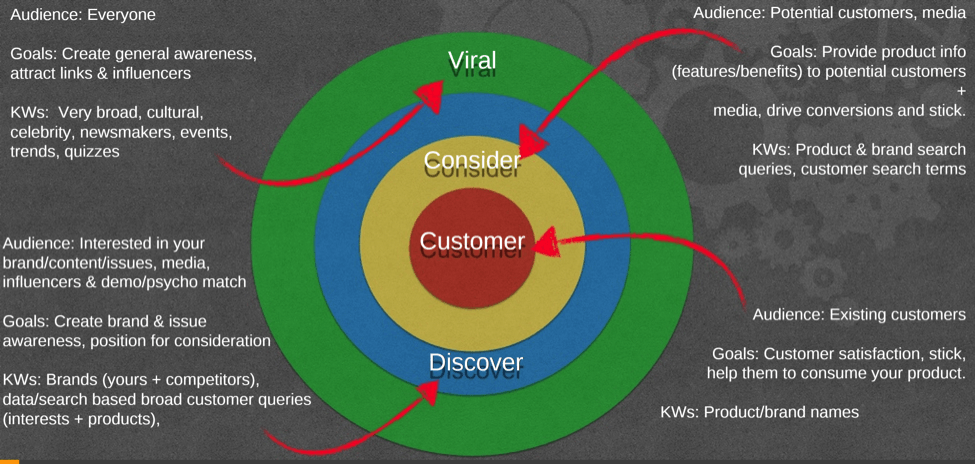
As you consider the different audiences, goals and keywords for each different customer life-cycle segment, you can see that the types of content you will want to create for them will vary. The image below shows three hypothetical businesses and the different types of content that they would potentially create for each of the four different life-cycle segments.
The first headline in each of the four life-cycle stages is for a financial planning business. In that case, appealing to a very wide audience who has no known or stated interest in financial planning would require broad, non-financial planning focused content that could start them on the path to more in depth information as they progress through the customer life-cycle.
The viral stage content might simply be a quiz designed to appeal to everyone’s curiosity that asks, “Can We Guess Your Real Age?” In the Discovery stage, we pose the more financially focused question “Who Really Gets Your Money If You Die Without A Will?” It’s still appealing to curiosity, but now we’ve narrowed our target-market focus a bit and addressed a known issue that we know our target market is facing.
When the prospect moves on to the Consideration stage, we get even more specifically targeted to the specific needs and issues of our prospective customer with “Which XYZ Financial Plan Is Right For You?” to help them compare our services to the competition or the various financial plans or services offered by our firm.
Last, but not least, for existing customers, we want to create content that promotes “stickiness” and helps them consume the products or services they already bought from us, or that exposes them to our other products or services that they might be interested in purchasing . So, here we go with a title like “How To Get The Most From Your XYZ Financial Advisor.”
The second set of headlines in the graphic above applies to a do-it-yourself (DIY) blog, beginning with the viral “How To Make Cheese With Your Feet?” and ever-narrowing to “23 Cheese Recipes Beginners Can Make At Home,” then a live-test review video of a product we offer, and finally an advanced product upsell offer.
The third set of headlines in the graphic applies to a marketing blog, and we progress through the various customer life-cycle stages from the very broad “17 Bad Jokes Only Marketers Will Get” to the issue/interest appeal of “10 Random Words That Are Killing Your Marketing Messages,” to a “how-to” article and, finally, a template post.
Strategy #1: Create Curated Data-Driven Content That Ranks For Hundreds Of Keywords
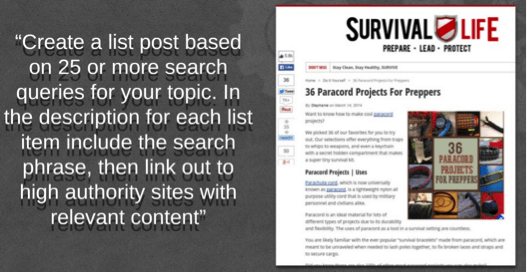
Strategy 1 is to create a list post (or “listicle”) comprising a list made up of 25 or more items. Each of the items in the list should be something that is already being searched for by your target market. The goal is to combine multiple search queries that are already getting traffic into a single article that will capture traffic around a large number of keywords and, hopefully, rank on page one for all of those keywords.
We pick the number of 25 or more items because our research has shown that longer lists (and longer articles generally) get more traffic and generate more time on page and more shares than shorter lists, but you can create a list of any length that feels right for you.
50% of the content that we create follows this strategy. For this strategy, we use SEMrush to identify the content that our market is searching for. For purposes of this post, I’m going to assume that you already know how to use a tool like SEMrush to identify your competitors and do basic keyword research. If you need a refresher on that, check out this excellent webinar on how to use SEMrush for keyword research.
First, let’s login to SEMrush and look down the left side of the dashboard under the “Keyword Research” section and choose “Full Search” as shown in the image below.

In the search bar (#2 in the image above), type in your keyword phrase and click the “Search” button. For our DIY site in the example above, I’ve entered one of our targeted keyword phrases, “DIY Projects” and SEMrush returns 483 results (#3 in the image above). Next, let’s sort those by search volume by clicking on the “Volume” column as shown in #4 in the image above.
As you can see, our primary search term, “DIY Projects,” gets just over 60,000 monthly searches. We want to learn two important things from these results:
- What voice does our audience respond best to? And,
- What “call-outs” should we use to address specific sub-audiences within our main audience?
Use SEMrush To Identify “Voice,” Appealing Modifiers, Sub-Interests and Sub-Audiences
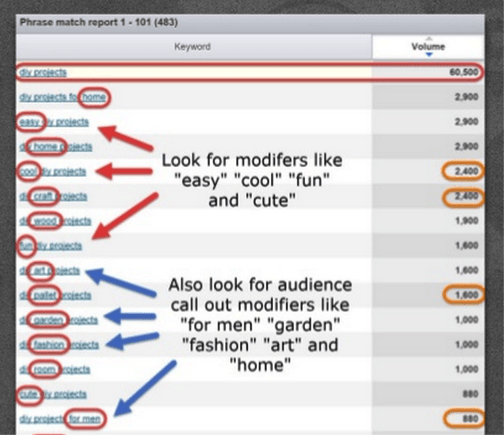
Let’s look more closely at the results and see what we can find out…
As you can see from the image above, the third most searched for keyword phrase is “easy DIY projects” with 2,900 searches per month. The fifth most searched for phrase is “cool DIY projects” with 2,400 monthly searches, followed not far behind by “fun” with 1,600 searches and “cute” with 880.
Using this data, we now know that there is a significant portion of our audience that is very specifically interested in learning more about things that are easy, cool, fun and cute. Armed with that knowledge, we can start framing our content, and the voice we write to our audience in, around those terms.
Speaking of audience, what else can we learn about our audience from these results? Well, the 4th results shows us that they are interested in projects for the “home” with 2,900 searches. They also like “craft” projects (2,400 searches), “wood” projects (1,900 searches), “art” (1,800 searches) and so on.
Additionally, we can see that people also want to know about DIY projects for specific sub-groups like “men” with 880 searches.
Creating Data-Driven Content That Ranks and Drives Traffic
Using this data, we know that we can create content and soak up search results for craft, wood and art projects for the home that are easy, cool, fun and cute and that appeal to men. Get the idea?
Okay, so now that we’re getting the hang of this, let’s use SEMrush to build a high-ranking, search query driven post. Take a look at the image below:
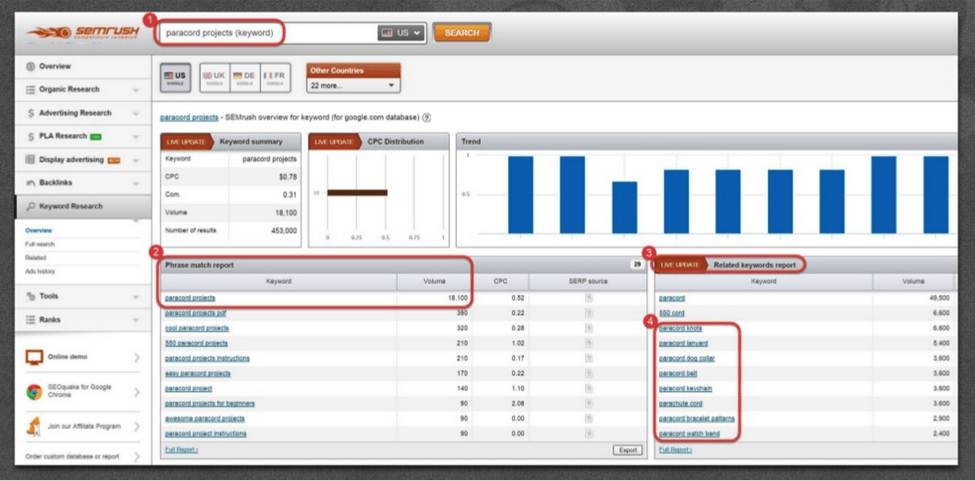
Start by finding the “Keyword Research” section on the left side dashboard and clicking on the “Overview” selection. In the search bar (#1 in the image above), I’ve typed the keyword phrase “paracord projects” that I found to be of interest to the DIY market using the research method we just completed in the last section.
As you can see in #2 in the image above, the phrase match report tells us that there are 18,100 searches each month for our primary term. Here, we’re interested in creating content around and ranking for this highly desirable and well-trafficked keyword phrase, so let’s take a look at searches that Google says are related to the main keyword.
Ready for More Conversion-Boosting Tips?
Join the worldwide community of conversion optimizers at ConvCon 2017!
SEMrush gives us this info in #3 in the image, via the Related Keywords Report. This basically saves you the time it would take to search the main term in Google and assemble all of the related search results that show up at the bottom of the page, and it also gives you more in depth information.
Looking at the list of related search phrases in the image below, we can get some great ideas for a listicle (the increasingly popular list article) about all the different paracord projects you can make:
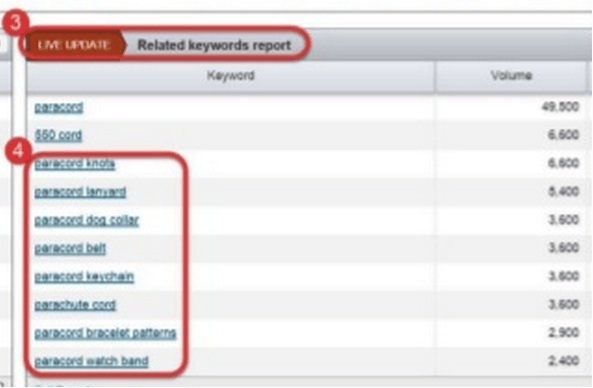
With thousands of searches for phrases like paracord “knots,” “lanyards,” “dog collar,” “belt,” “keychain,” “bracelet” and “watch band” this seems like the perfect opportunity to do a roundup article that lists several great resources for creating all of these specific paracord DIY projects.
Creating the Content From the Data
The next step is to source the content for the keywords that we identified that we want to build our content around. Since we are doing a list article to maximize our opportunity to rank for the maximum number of keywords, all we have to do is go and look at the SERPs for each of the different projects we want to include in our article. Here’s how you do that:
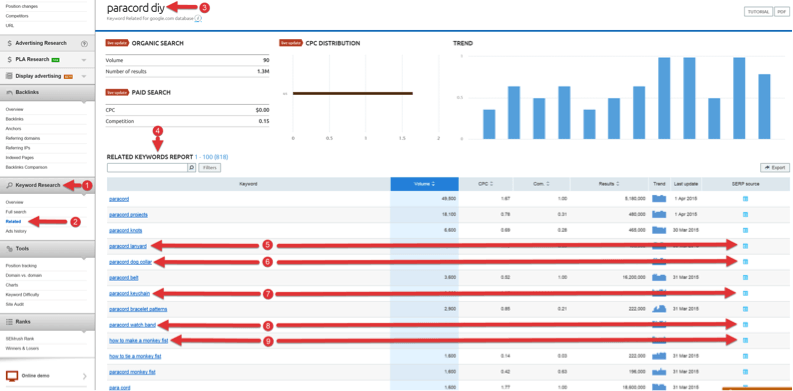
We start out under the “Keyword Research” section of the left dashboard (Item #1 above). Then we click on “Related” to do a related search (Item #2 above), and we enter our search term “DIY Paracord” in the search box (Item #3 above). Click the “Search” button and the resulting Related Keywords Report (Item #4).
Now, all we have to do is click on the “SERP source” column on the little SERP page icons (Item #5 – Item #9), and we can easily find the appropriate content to curate. Each icon that we click on reveals the SERP pages for the applicable keyword phrase and each SERP has clickable links to take us to the content for the keyword phrase. Click each one, and move between web, images and videos to see different kinds of content. See image below.

You should be able to find all the content that you want or need to use in your list curation post from these SERP pages, and the beauty of this content is that it has already proved itself by ranking in the SERPs in the first place.
Well, that’s exactly what we did. So, let’s take a look at it and the results and see if this stuff actually works. Here’s a link to the article we created for our SurvivalLife blog from the research we did above.
http://survivallife.com/2014/03/14/36-paracord-projects-preppers
Note that we took what we learned from the research we did above and made a list of the top 36 projects based on what people are already searching for. We didn’t have to brainstorm, and we didn’t have to guess, we just searched for our primary keyword phrase “paracord projects” and then let the data do the rest.
If you take a look at the article we created from this research, you will see that the 36 paracord projects we described in the article include projects for paracord knots, lanyards, dog collars, belts, keychains, bracelets and watch bands (sound familiar?) along with the other projects we found in the Related Keyword Report.
Check it out:
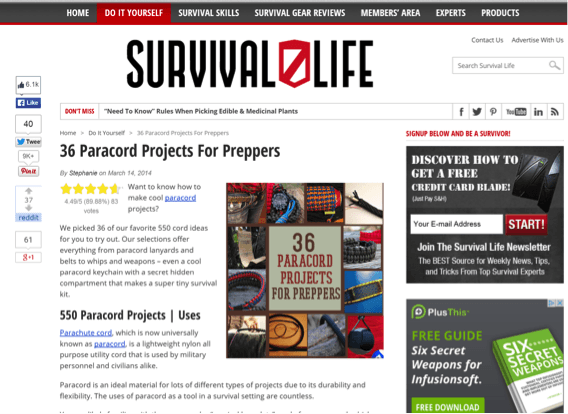
That’s Cool, But Does It Drive Traffic?
Great question! I’m glad you asked. Let’s take a look at Google Analytics for SurvivalLife and find out.

Yep, turns out that in January, this baby was responsible for over 41,000 page views with an average time on page of over 5 minutes! That’s another huge advantage of doing these kinds of posts. The time on page, one of the most important Google SERP ranking factors, is off the chart, because there is so much content for your visitors to consume.
Note: Including links back to the content you plucked from the authority sites from your list curation post gives proper attribution to the original poster and also helps the authority of your post. Oh, and be sure that you are truly curating and not stealing someone else’s content.
Case Study – Strategy 1: 487 Keywords Ranked On Page 1 Of Google
One of the most exciting things about creating these kinds of posts is that you can rank on Page 1 of Google for literally HUNDREDS of keywords with a single piece of content. Imagine, create one piece of content, one time, and rank on page 1 for almost 500 keywords. That’s exactly what we did with the paracord projects post.
Take a look:
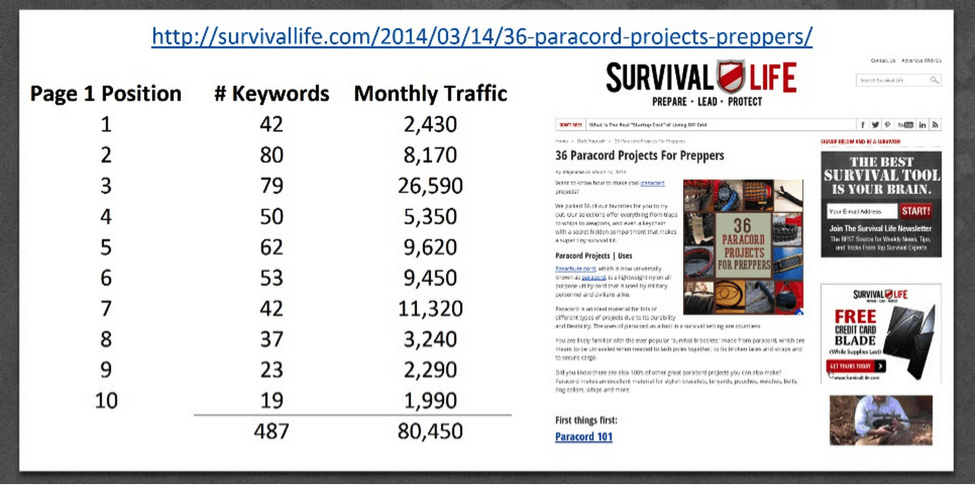
But wait, do you have to create all of this content yourself? Of course not! This is the perfect opportunity for you to create curated posts. If you take a look at what we did in the paracord article, you’ll see that we plucked almost all of the projects and detail on how to do them from other sites.
The bottom line is that you can use SEMRush to do your keyword research and some data drill down and start creating posts like this in no time at all using one of my favorite tools of all, OPC (other people’s content).
Summary of Strategy #1
- Step 1:Do a Full Search for your primary Keywords to discover your audience’s voice, sub-interests and audience niches within your primary audience.
- Step 2:Do a Related Search on those keyword ideas to find “listicle” topics
- Step 3:Create a listicle post using the data you discovered and link out to other people’s content on high authority domains.
Have you used this strategy before? Let us know all about it in the comments and be sure to check back for the next post in this series.
This article first appeared on the SEMRush Blog, republished with permission from the author.
About the Author
 An attorney who specializes in negotiation, copywriting, marketing strategies, mergers, acquisitions and exit strategies, Roland Frasier is one of the principals of Idea Incubator and Digital Marketer. After he completed law school, Roland opened his own law practice, acting as managing partner and taking responsibility for all the marketing and advertising. During that time he began joint venturing deals with clients and gradually evolved from practicing law to buying and selling companies, repositioning businesses and direct response marketing.
An attorney who specializes in negotiation, copywriting, marketing strategies, mergers, acquisitions and exit strategies, Roland Frasier is one of the principals of Idea Incubator and Digital Marketer. After he completed law school, Roland opened his own law practice, acting as managing partner and taking responsibility for all the marketing and advertising. During that time he began joint venturing deals with clients and gradually evolved from practicing law to buying and selling companies, repositioning businesses and direct response marketing.
Over his career, Roland has done infomercial deals with Gunthy-Renker and K-Tel Direct, publishing deals with Simon & Schuster and Random House, negotiated shows with major hotels on the Las Vegas strip, been involved in over 100 private and public offerings, run international hedge funds, worked with copywriting great Gary Halbert, created presentations and marketing campaigns for major brands and much more.

 717 798 3495
717 798 3495



